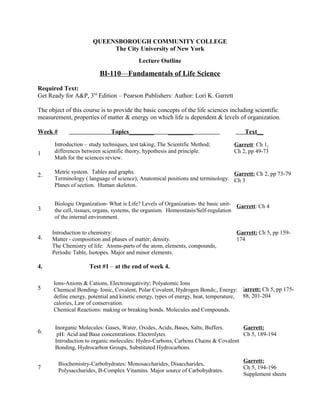B io 110 academy specific syllabus queensborough
- 1. QUEENSBOROUGH COMMUNITY COLLEGE The City University of New York Lecture Outline BI-110—Fundamentals of Life Science Required Text: Get Ready for A&P, 3rd Edition – Pearson Publishers: Author: Lori K. Garrett The object of this course is to provide the basic concepts of the life sciences including scientific measurement, properties of matter & energy on which life is dependent & levels of organization. Week # Topics________ ________ Text__ 1 2. 3 4. 4. Test #1 – at the end of week 4. 5 6. 7 Introduction – study techniques, test taking; The Scientific Method; differences between scientific theory, hypothesis and principle. Math for the sciences review. Garrett: Ch 1, Ch 2, pp 49-73 Metric system. Tables and graphs. Terminology ( language of science); Anatomical positions and terminology. Planes of section. Human skeleton. Garrett: Ch 2, pp 73-79 Ch 3 Garrett: Ch 5, pp 159- 174 Garrett: Ch 4 Garrett: Ch 5, 189-194 Garrett: Ch 5, pp 175- 188, 201-204 Introduction to chemistry: Matter - composition and phases of matter; density. The Chemistry of life: Atoms-parts of the atom, elements, compounds, Periodic Table, Isotopes. Major and minor elements. Biologic Organization- What is Life? Levels of Organization- the basic unit- the cell, tissues, organs, systems, the organism. Homeostasis/Self-regulation of the internal environment. Ions-Anions & Cations, Electronegativity; Polyatomic Ions Chemical Bonding- Ionic, Covalent, Polar Covalent, Hydrogen Bonds;, Energy: define energy, potential and kinetic energy, types of energy, heat, temperature, calories, Law of conservation. Chemical Reactions: making or breaking bonds. Molecules and Compounds. Inorganic Molecules: Gases, Water, Oxides, Acids, Bases, Salts; Buffers. pH: Acid and Base concentrations. Electrolytes Introduction to organic molecules: Hydro-Carbons, Carbons Chains & Covalent Bonding, Hydrocarbon Groups, Substituted Hydrocarbons. Biochemistry-Carbohydrates: Monosaccharides, Disaccharides, Polysaccharides, B-Complex Vitamins. Major source of Carbohydrates. Garrett: Ch 5, 194-196 Supplement sheets
- 2. 8. 8. Test #2 – at the end of week 8 9. 10. 11. Replication, Transcription and Translation; Genetic Code; gene expression 11. Test #3 – at the end of week 11 12. 13. 14. 15 Test #4 – during Finals week. This syllabus is merely a guide to the course. Instructor will determine the actual schedule. Grading: 4 tests each 25% of the grade – 100% Note: 1) No test results are dropped in computing the grade for any student 2) Grades are determined by the student’s average---there is no curving of marks in computing grades. 3) Attendance will be taken at each class meeting, and the QCC requirements shall be enforced. 4) The use of electronic devices, including cell phones, is strictly prohibited at all times. Garrett: Ch 5, 198-199 Supplement sheets Garrett: Ch 5, 200-201 Supplement sheets Garrett: Ch 5, 197 Supplement sheets Biochemistry- Lipids: Fatty Acids, Glycerides, Triglycerides, Saturated, unsaturated & polyunsaturated, Phospholipids, steroids. Major sources of Lipids Biochemistry- Proteins: Amino acids the basic building blocks of proteins, Peptide Bonds, Protein Structures, Denaturation, Protein Functions, Protein Shapes Enzymes. Biochemistry – Nucleic Acids: Nucleotides RNA, DNA, ATP revisited, DNA Helix, Chromosomes. Supplementary sheets Cell Structure: Composite Cell: Cell membrane, cell nucleus, organelles. Cell cycle. . Movement- Diffusion, Osmosis, Facilitated Diffusion, Filtration; Garrett: Ch 6, 209-230, 243-249. Garrett: Ch 6, 231-239 Active transport; endocytosis; exocytosis Membrane channels, pores; Control of movement through gated channels. (nervous system/muscle examples). Garrett: Ch 6, 240-243

